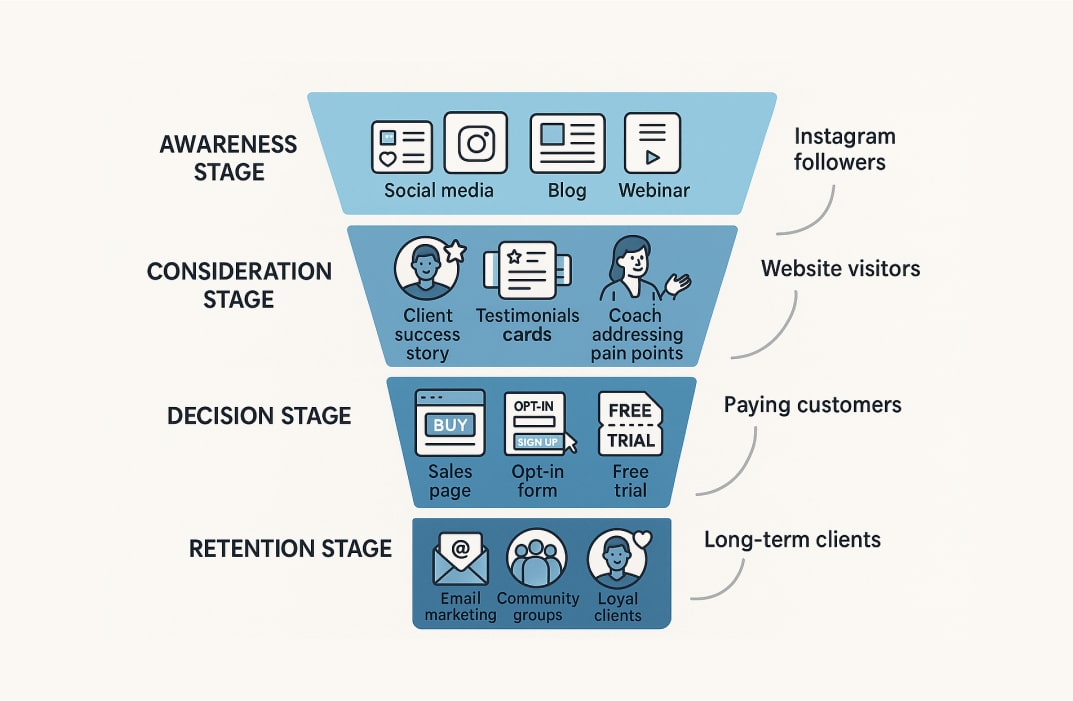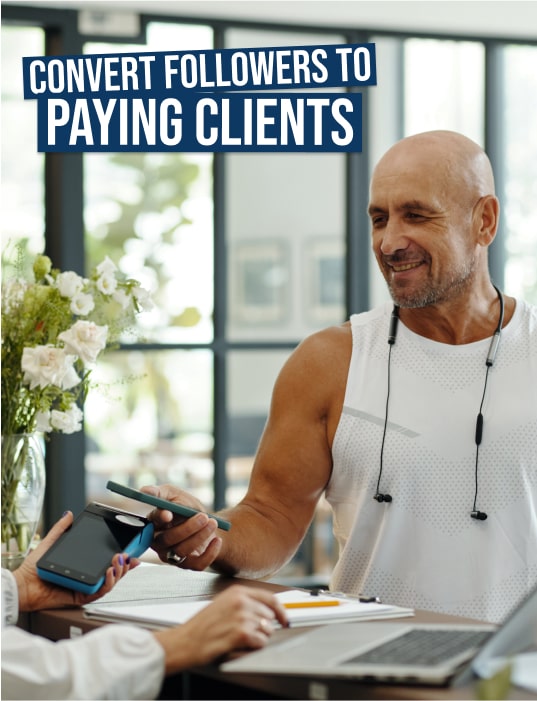Are You Earning Up to Your Potential?
Most personal trainers are undervaluing their time and skills. Our Personal trainer Revenue Calculator helps you find out what you should be making, and how to get there.
No guesswork. Just real numbers.
.jpg)
Ever wondered why some coaches effortlessly convert followers into high-paying clients while others struggle to book a single call? It’s not luck. It’s not the algorithm. It’s the funnel behind the content, and how strategically it guides people from discovery to decision.
Most fitness coaches are doing all the “right things.” They're posting workouts, sharing transformations, dropping value daily yet still struggling to turn followers into actual clients. The real frustration isn’t a lack of content…it’s that all that effort leads to likes, saves, and DMs, but not consistent sign-ups or predictable income.
And that’s where the pain truly hits: you’re working harder than ever on social media, but your business still feels stuck. Followers aren’t becoming leads. Leads aren’t becoming clients. You’re trapped in a cycle of posting without payoff, wondering what successful coaches are doing differently.
This blog breaks down that system through a complete fitness funnel example for coaches. A step-by-step journey that shows exactly how top trainers convert casual viewers into engaged leads and high-paying clients. You’ll learn how each funnel stage works, the type of content that drives movement, and how to build a predictable path that takes someone from discovering your brand to joining your program with confidence.
By the end, you’ll understand the exact funnel successful coaches use, and how you can build the same engine to grow faster, close more clients, and finally turn your audience into real revenue.
What Is a Fitness Funnel and Why Do Coaches Need One?

A sales funnel is a strategic process that moves potential clients from awareness to decision-making, ultimately converting them into paying customers. For fitness coaches, this means turning Instagram followers, website visitors, or email subscribers into members of your online academy, clients for marathon training, or loyal participants in your online business.
A good fitness funnel example for coaches typically includes:
- Awareness stage: Attracting prospective customers through social media marketing, Instagram stories, blog posts, or free webinars.
- Consideration stage: Building trust with valuable content, showcasing client success stories, and addressing client pain points.
- Decision stage: Presenting offers such as free trials, sales pages, or an opt-in form to encourage sign-ups.
- Retention stage: Using email marketing and community engagement to retain customers, nurture future purchases, and boost customer lifetime value.
For coaches, a successful sales funnel provides a predictable sales pipeline that not only generates quality leads but also helps build lasting relationships with loyal clients.
{{gym-name-generator-form="/blog-gym-name-generator"}}
💪 Got an idea for a brand? Let's bring it to life.
Launch your own fitness app with FitBudd in minutes!

💪 Got your brand name? Let’s bring it to life.
Launch your own fitness app with FitBudd in minutes!


88% trainers worldwide gave us 5 stars
Transform your fitness business with the power of your branded app on iOS and Android.
Try for FREEWhy Social Media Is the Top of the Funnel

Instagram Marketing for Fitness Coaches
Social media has become the go-to platform for fitness professionals to attract a target audience and spark interest in their services. With billions of daily users, platforms like Instagram, TikTok, and Facebook offer unparalleled opportunities to showcase engaging content, build social proof, and connect with potential buyers across diverse customer segments. Whether you’re sharing quick tips, workout snippets, or motivational messages, social media acts as the awareness stage of your sales funnel, where new people first discover your fitness business.
Instagram is mighty because of its visual focus and interactive features like:
- Instagram stories and reels for workout demonstrations that highlight your training style.
- Social media posts showcasing success stories and transformations from existing customers.
- Behind-the-scenes looks at your personal trainer journey, making you more relatable and authentic.
- Interactive polls, quizzes, and Q&As to uncover your audience’s pain points and spark conversations.
Beyond visuals, Instagram also supports Various marketing strategies, including carousel posts for educational content, Instagram Stories for time-sensitive promotions, and highlights for long-term visibility.
When done consistently and strategically, this approach not only generates leads but also builds trust over time. Each piece of content should guide followers toward your landing page or opt-in form, where they officially enter the next stage of your marketing funnel and start the journey from website visitor to qualified lead and eventually to a paying client.
Building a Sales Funnel for Your Online Training Business
Suppose you’re wondering how to convert Instagram followers into fitness clients. In that case, the key is to design a fitness funnel example for coaches that aligns with your coaching style, services, and long-term business goals. A well-structured funnel helps simplify the sales process, keep track of your sales pipeline, and guide people smoothly from discovery to decision-making. Here’s what a typical sales process looks like for a coach:
1. Awareness Stage – Attracting Potential Clients
At this stage of the funnel, the primary goal is visibility and reach. You want to connect with website visitors, prospective customers, and potential buyers who are just beginning to learn about your fitness business and what makes your approach different. Building interest at this stage lays the foundation for the rest of the customer journey.
Tactics include:
- Posting valuable content on social media that educates, entertains, or inspires your target audience.
- Hosting a free webinar or live Q&A session to showcase your expertise and build credibility.
- Sharing an informative blog post on fitness tips, nutrition hacks, or client success stories that address common pain points.
- Offering a freebie like a “7-Day Fitness Challenge” with an easy-to-use opt-in form to start building your email list.
2. Consideration Stage – Educating and Nurturing Leads
Once you’ve caught their attention in the awareness stage, it’s time to provide deeper, valuable insights that build trust and position you as the go-to solution for their pain points. At this point in the customer journey, prospects are actively comparing options, so your role is to communicate effectively, demonstrate credibility, and keep them engaged. Your marketing team (or you as a solo fitness coach) should focus on nurturing leads, strategies such as:
- Sending automated email marketing sequences that educate, inspire, and gently guide them through the buying process.
- Sharing detailed client success stories with before-and-after results to highlight transformation and boost confidence in your methods.
- Offering free trials of your online course or online academy allows prospects to experience your coaching style first-hand.
- Creating social proof through testimonials, reviews, and social media posts that show real people achieving results under your guidance.
By consistently delivering valuable content during this stage, you increase the likelihood of converting prospective customers into qualified leads who are ready to progress in the sales cycle.
3. Decision Stage – Converting Leads to Paying Clients
At the decision stage, your primary responsibility is to make the buying process as easy, seamless, and compelling as possible. This is the moment when prospective customers are ready to become paying clients, but they still need reassurance and clarity before committing. A sales funnel consists of clear, well-placed calls to action that guide customers toward making a purchase. Effective strategies include:
- Directing leads to a persuasive sales page that highlights benefits, addresses common objections, and showcases strong social proof through testimonials and success stories.
- Offering exclusive deals or limited-time discounts for first-time purchases to create urgency and encourage quick decisions.
- Simplifying the sign-up process with streamlined, mobile-friendly forms that work flawlessly across mobile devices, ensuring no friction for busy users.
- Having a responsive sales team or an automated chatbot available to communicate effectively, answer last-minute questions, and remove doubts from potential buyers.
By optimizing this stage of the sales cycle, you can turn qualified leads into paying customers while boosting customer acquisition and laying the groundwork for long-term business growth.
4. Retention Stage – Keeping Clients Engaged
A good sales funnel doesn’t end once you’ve converted someone into a paying client—in fact, this stage is just as critical for long-term business growth. The real profitability of a fitness business comes from your ability to retain customers, increase customer lifetime value, and encourage future purchases through ongoing engagement. Keeping your clients excited, motivated, and connected ensures they stay active members of your programs while also becoming advocates for your brand.
Ways to strengthen client retention include:
- Offering exclusive, members-only content through an online academy, such as advanced training modules, nutrition guides, or bonus workout plans.
- Providing regular email marketing updates with actionable fitness tips, early access to offers, and special deals designed to reward loyal clients.
- Showcasing the success stories of existing customers to build a sense of community and inspire new and returning members to push forward in their own journeys.
- Encouraging referrals from satisfied, loyal clients by offering incentives like discounts, free sessions, or VIP perks for every successful referral.
When you continue to deliver valuable content and memorable customer experiences, you not only nurture leads into loyal clients, but you also create a cycle of advocacy and repeat sales that drives steady, predictable business growth.
Fitness Funnel Example for Coaches in Action
Let’s look at a real fitness funnel example for coaches to understand how it works in practice.
Step 1: Attract with Social Media
A fitness coach posts Instagram marketing content like workout demos, transformation success stories, and motivational social media posts. Each post includes a call-to-action leading to a landing page.
Step 2: Capture Leads
On the landing page, the coach offers a free 5-day online training program, accompanied by an opt-in form. This helps collect emails and generate qualified leads.
Step 3: Nurture with Email Marketing
The coach sends a series of email marketing messages containing valuable insights, nutrition tips, and client success stories. This builds credibility and keeps prospective customers engaged.
Step 4: Convert with Offers
An automated sales page introduces the coach’s premium online course on strength training or marathon training. Limited-time discounts or free trials increase conversions.
Step 5: Retain and Upsell
Once converted, clients are invited into a private community where they get engaging content, access to advanced online academy courses, and encouragement for future purchases.
This sales cycle ensures that potential clients become paying clients, while existing customers stay loyal, boosting overall customer lifetime value.
Key Marketing Strategies for Fitness Coaches
To create a successful sales funnel, fitness professionals need more than just good content—they need a structured approach to reaching, educating, and converting their target audience. Here are some must-know marketing strategies for fitness coaches that ensure your sales process remains strong at every funnel stage:
Digital Marketing First
Use a mix of social media, informative blog posts, and targeted paid ads to reach broader customer segments and attract potential clients to your online business.
Email Marketing Automation
Keep prospective customers engaged with scheduled email sequences that nurture relationships, deliver valuable insights, and guide them through the buyer journey.
Social Proof Everywhere
Highlight success stories, testimonials, and real-life transformations on your sales page, social media posts, and even in email marketing campaigns to boost credibility.
Optimize for Mobile Devices
Since most website visitors will interact with your site through their mobile devices, ensure that your sales page, opt-in form, and landing page are optimized for mobile devices and easy to navigate.
Segment Your Leads
Divide your customer segments into beginners, intermediates, and advanced trainees so you can deliver tailored offers and valuable content that speaks directly to their needs.
Communicate Effectively
Whether through your sales team, direct DMs, or personalized emails, clear communication helps build trust and removes friction from the sales cycle.
Track Your Sales Activities
Measure every stage of your sales pipeline to identify what’s working, where leads drop off, and how to improve your sales funnel for greater business growth.
By combining these strategies, fitness coaches can consistently attract high-quality leads, nurture them with engaging content, and ultimately convert them into long-term, loyal clients.
The Role of Customer Experience in Fitness Funnels
A fitness coach’s reputation depends heavily on the overall customer experience they deliver. A smooth and supportive buyer journey—from the awareness stage to the decision-making process and beyond—ensures you build not just paying customers, but long-term loyal clients. When prospects feel guided, valued, and cared for, they’re far more likely to stay engaged and continue investing in your fitness business.
Coaches must focus on:
- Quick response times on social media to show attentiveness and build trust with potential clients.
- Providing valuable content that addresses real pain points and demonstrates an understanding of different customer segments.
- Following up with personalized future purchase offers, such as advanced programs, upgrades, or exclusive access to an online academy.
- Encouraging engagement with social media posts, live chats, or community groups that keep both existing customers and new leads connected and motivated.
When your customer acquisition strategy aligns seamlessly with an exceptional service experience, you not only attract more clients but also create a cycle of retention, referrals, and business growth. This combination of strong sales activities and a positive customer journey is what separates an average funnel from a truly successful sales funnel.
Why Coaches Should Document Success Stories
Every successful sales funnel relies on social proof. Sharing client success stories through blog posts, Instagram stories, or video testimonials helps convince potential buyers that your program works.
This also helps nurture leads by reducing doubts in the consideration stage of the sales cycle. Real-world examples of people overcoming pain points through your training demonstrate value more powerfully than any sales pitch.
The Bottom Line
A fitness funnel example for coaches illustrates how structured marketing can effectively convert social media followers into paying clients. By combining digital marketing tactics like Instagram marketing, email marketing, and engaging content, fitness professionals can:
- Generate leads through social media posts and opt-in forms
- Nurture leads with valuable insights and success stories
- Convert potential clients into paying customers via sales pages
- Retain customers for future purchases and long-term business growth
If you’re a fitness coach looking to grow your online business, the key lies in creating a sales funnel tailored to your target audience. By following this roadmap, you’ll not only attract more clients but also ensure a thriving community of loyal clients who trust your guidance.
FAQS
What should be included in a coaching funnel?
A coaching funnel should guide prospects from discovery to becoming paying clients while also encouraging future purchases. A strong funnel usually includes:
- An awareness stage with social media marketing, blog posts, or free webinars to attract potential clients.
- A consideration stage with valuable content, client success stories, and free trials to build trust.
- A decision stage with persuasive sales pages, opt-in forms, and clear calls-to-action to convert qualified leads.
- A retention stage where you keep loyal clients engaged through email marketing, members-only content in an online academy, and referral incentives.
Together, these steps create a successful sales funnel that supports consistent business growth for fitness coaches.
How do fitness coaches find clients?
Fitness coaches find clients by combining digital marketing strategies with personal engagement. Popular methods include:
- Leveraging Instagram marketing and social media posts to attract potential buyers.
- Hosting free webinars or challenges that provide valuable insights and generate quality leads.
- Using email marketing to nurture relationships and guide prospective customers through the sales cycle.
- Sharing social proof in the form of testimonials, success stories, and transformation results.
- Networking through local gyms, events, or online communities to connect with potential clients directly.
By creating a well-structured marketing funnel, fitness coaches can consistently generate more clients while building trust and credibility.
What qualifications are required to be a fitness coach?
The qualifications depend on your niche, but most fitness professionals benefit from:
- A recognized personal trainer certification (such as ACE, NASM, or ISSA).
- Specialized training in areas like marathon training, nutrition, or corrective exercise.
- Experience working with diverse customer segments (beginners, intermediates, or advanced trainees).
- Strong communication skills to guide customers through the journey effectively.
- Knowledge of digital marketing and sales activities to grow your online business.
While formal education helps, many clients value success stories, your ability to solve their pain points, and a proven track record of results just as much.
How to market yourself as a fitness coach?
Marketing yourself as a fitness coach requires blending engaging content with clear marketing strategies:
- Establish a strong presence on social media through educational videos, Instagram Stories, and motivational posts that engage your audience.
- Share client success stories and testimonials to provide social proof and inspire potential clients.
- Create a professional landing page or sales page with an opt-in form to capture leads.
- Use email marketing automation to deliver ongoing valuable content and nurture relationships.
- Offer free trials, sample programs, or mini online courses to give prospects a taste of your coaching style.
- Network with other fitness professionals, collaborate on content, and engage with your target audience in online communities to expand your reach and build your brand.
By consistently showcasing your expertise and delivering value, you position yourself as a trusted authority and attract paying customers to your fitness business.
Frequently Asked Questions

Ultimate Marketing Guide for Fitness Trainers
Boost your business growth with these tried and tested marketing strategies. Free for you to download.
Download Now
Templates
These functional templates have the power to make any fitness trainer's life easier.
Subscribe To
Our Blog



























The best funnels aren’t built on hard selling, they’re built on trust. People only buy when they feel like you genuinely understand their struggles. Your content should teach, simplify, and solve problems so followers can already feel the transformation before they ever work with you. When you lead with value, people naturally move towards coaching because they trust you to guide them. The funnel becomes effortless.
Amy Hollings
Fitness Trainer & Weight Management Specialist